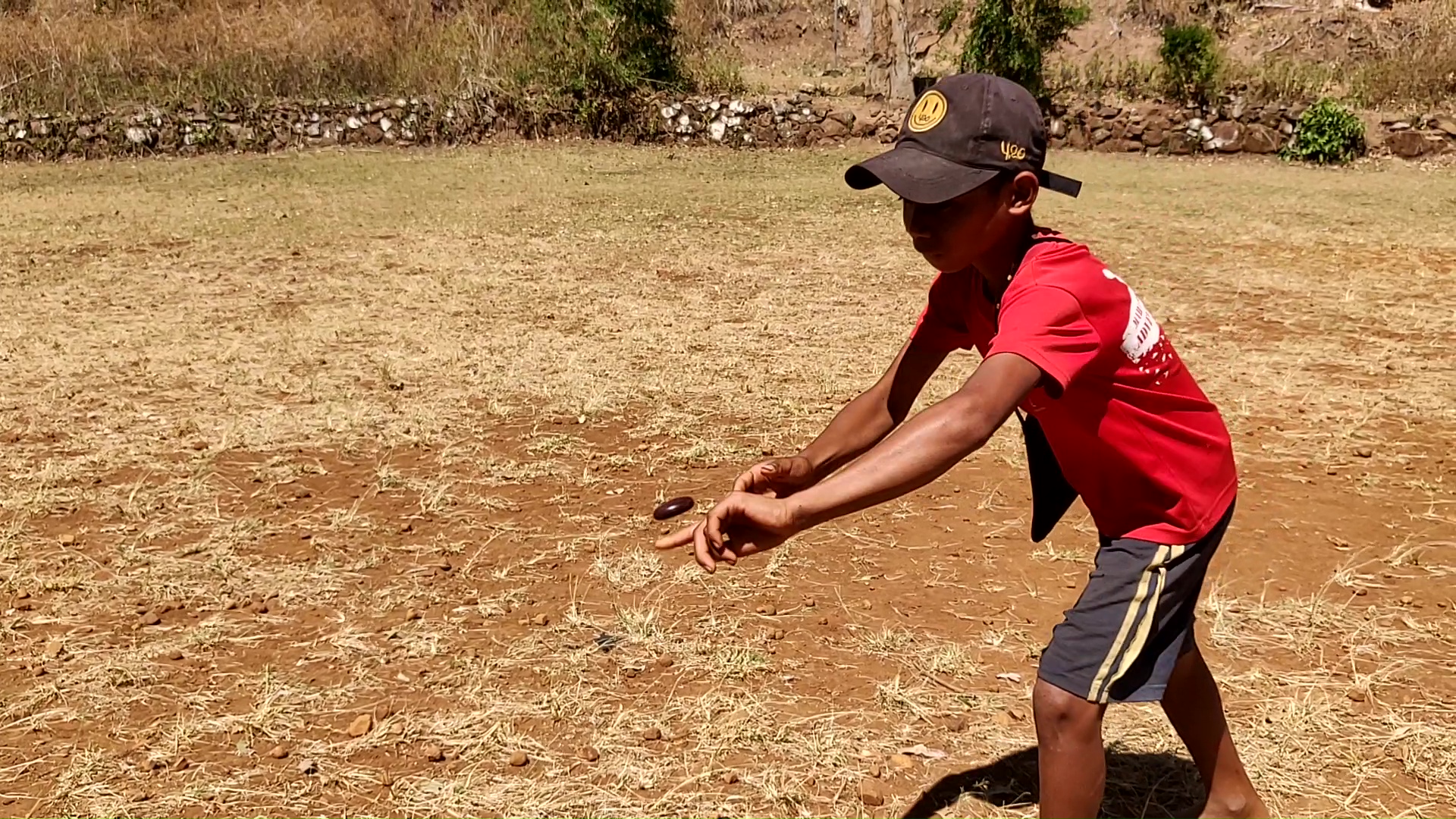
Kalik (Timor-Leste)
- Name of sport (game): Kalik
- Place of practice (continent, state, nation):
Kalik game has been practiced/played mainly among young people (7-17 years old) in the Bobonaro, Ermera, Manatuto, Manufahi, Baucau, Viqueque, and Lautem for generations throughout the history of Timor-Leste’s society.
- History:
In the past, Kalik game is one of the traditional games played by children’s and young adults in Timor-Leste. From the very early times of Portuguese era there was various traditional games played by children and young adults in Timor-Leste with the purpose of recreation and amusement among Timorese people. Even though there are difference in language, food habits and others however, the traditional games such as Kalik game were more or less same though the name and their rules differ from one place to another.
From the interview with KIIs and FGDs, the majority of respondents pointed out that Kalik game first time introduced by Timorese ancestors long time ago before the Portuguese arrival.
By the time this game was transmitted over the generation until now. This game rooted in Timor-Leste however, there is no clear date regarding when and where Kalik game was first introduce and play. Most of respondents described that this game mostly played during Portuguese time and by then it slowly disappeared as Indonesia invade Timor-Leste.
This study also revealed that respondents generally hear and learn for the first time how to play Kalik game from their grandfather and dad’s (22.7%), follow their colleagues or seniors (61.2%), and learn by their own and teachers (16.1%). This shows that there is no formal training or instructions on how to play Kalik game, rather follow-up players who play Kalik game in school and in other places.
According to Mr Tomas das Neves (Lia Na’in – Ermera) many of them have no doubt heard stories from their parents and grandparents of their idyllic village lives and the Kalik games they played during their joyful childhoods. But for most of children’s and young adults today, the games they have come to know are the single player ones on a bright screen and other games. Back in the day, Kalik games were creative – play out of pure imagination and items lying around – and children, as well as young adults alike, invented them to keep themselves entertained. - Description:
Hana Kalik
Hana Kalik is a target and shooting game. It requires high accuracy at different distances. The Kalik is accelerated and shot with a quick movement of the hand. Players or teams that oppose each other try to shoot down the Kalik of the opponents. This game is generally played by children and young adults between 7-17 years of age.
Background
Hana Kalik is a traditional game from Timor-Leste. It was popular among children and young adults in a pre-colonial time and during the colonialization era of Portuguese. Hana Kalik is still well known especially among the elder population and in some rural areas the tradition is still alive.
The Name
The name commonly used by the Timorese people is Hana Kalik (lit. shoot Kalik). The Kalik or St. Thomas’ bean is a large, woody, branched, evergreen climbing vine that grows about 100 m long and 18 cm in diameter. The seeds are used by locals for its medicinal and cosmetic properties, wild food and used to play Hana Kalik.The game can be played individually and collectively as a group. Played individually can be up to 5 players; whiles in groups, the two groups or team that against each other must be with the same players. The player in each team can be between two to five players. The Kalik game generally performs to strengthen the friendship, school break, family or community gathering, and herding livestock.
Since the detailed rules of the Kalik game are never written and no information available on how it was evolved and changed over time, as well as the game, is no longer played in most territories of Timor-Leste. The following rules of Kalik games presented below are constructed mainly based on the information collected throughout the study. Consequently, the set of rules derived from this study might be not exactly accurate as the original version of Kalik game that was once played in the past. The following section provides the minimum requirements needed to perform the game, general rules and objectives associated with Kalik game, details of modality and its specific rules associated with it.Minimum Requirement
To be able to perform Kalik game, the minimums requirements need to be available are:
❖ Playing Field - Kalik game is played on a piece of flat area (no muddy, no grass, and no rocky on the surface). There is no limit to the area for the game to be played but the wider the better;
❖ Equipment - Kalik bean, the minimum number of Kalik bean needed is equal to the number of players.General rules and objectives of Kalik game
It is commonly agreed that Kalik game is a competition for accuracy in shooting or archery.
The aim is to shoot/hit or throws down Kalik bean from the opponent to reach the agreed winning/championship/finish points that are decided before started the game.How to start Kalik game
1. The Kalik game begins by determining who will play first, and it can be decided in various ways:
a) Flip a Kalik bean (mark wet in one side and dry on another side of the Kalik) to decide who or which team plays first. Before flip of Kalik bean, the player/team chose the wet or dry sites. The sites that show up are the one that will play first.
b) Each player cast the Kalik game into the pit, who is nearest or enters the pit, will plays first, and follow by the second nearest, and so on;
2. Players that play first take a stand or position to shoot first, and the other players/team putting or locating their Kalik bean at the predetermined position;
3. If the first player succeeds in shooting/arching the opponent's fruit then he will continue to shoot. If it fails, then it will be replaced with the next player. This cycle continues until one player/team reaches the winning points;
4. End of the game - the game is finish when a player/team has reached the winning point agreed by the players or succeeded in shooting down all the opponent’s Kalik beans.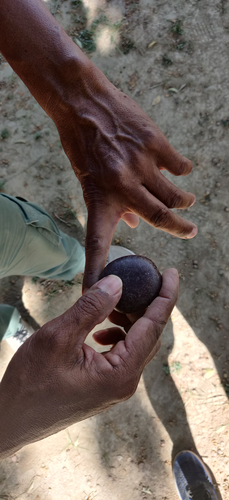
Scoring/point
Scoring or point in playing Kalik game occurs when the players/team members:
❖ Succeeded in shooting down/out/shoot the opponent's Kalik bean;
❖ Managed to throw the kalik bean into the pit/hole;
❖ The wining point ranging from 20 up to 100 points depending on the agreement made by players before started the game.Penalties
❖ The Kalik bean used for shooting or archery must not fall within one foot of the Kalik that is being shot;
❖ If there is collusion between two Kalik beans during the initial throw to determine who/which team plays first.Modalities of Kalik game
The result of the study shows that the modality of Kalik game can be categorized into five models. This includes
1) the hole model
2) The rectangular line model
3) The standing model
4) The Jot down model
5) The kneeling model.
However, between those models, the hole and standing models are the two models most popular one being played in the past, and it is still played by children in village of Wairoke today. The following section provides details of these models:The Hole Model
One of the most popular models of playing Kalik game in Timor-Leste is the Hole model. This model can be play by throwing Kalik to the hole. This is quite similar to the game of marbles.
Technically, it can be played one on one or in pairs/groups. Each player holds one Kalik, then makes one hole in the middle and stands a line 2-5 meters away from the hole towards the player. The hole model has two types of game with slightly different of its playing field/design as shown in Figure 2a and 2b. In addition, the details of a specific rule, winning points, penalty, and determination of the winner for these two types are presented in the table.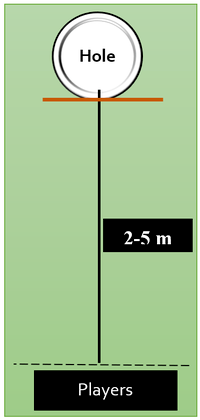
The player with the closes Kalik into or enters the hole is the first to play or to start the game, while the player who drops the Kalik with the farthest distance from the hole is the last to play.
Then the first player starts throws/hana his/her Kalik, to the opponent’s Kalik. One shoot collects one point until it reaches the score that is set and agreed upon before starting the game (20-100 points). If the first player manages to shoot/throw another Kalik without misses until it reaches the agreed score, then the game is over, and he is the winner. However, if he misses once in his throw, he stops, and the second player continues the game and so on until the game is over.The Standing Model
The standing model of Kalik game can also be played individually (one on one up to five players) or collectively in groups. Each player holds one Kalik, and the first player/team to play first takes a stand behind the line, about 1-5 meters away from the first standing Kalik, and the opponents positioned their Kalik standing straight in the vertical direction to the players.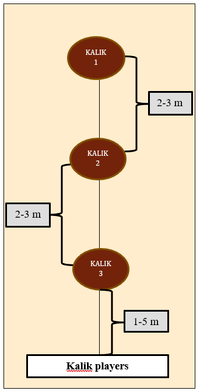
Square Line Model
The Square line model of Kalik game can be played individually/singles and groups. This type of model played by two opposing teams. The objective for the players or team is to shoot or
knock Kalik outside the square/rectangle line. The model of square/rectangle has two different types in which Kalik is standing - frontal and lateral, and shared the same rules 3-5 Kalik are located/positioned inside the square with the distance of 30-50cm between Kalik.Jot down model (apontador)
The jot down model of Kalik game is generally played singles. Two until five individuals opposing each other play it. The objective for the players is to shoot or knock the Kalik that positioned in predetermined position. To begin play the jot down model, flip of Kalik or the agreement between players to decide who play first and so on. The rule apply in jot down model is simple. Players take position behind the boundary line; the first player shoot the Kalik, if player manage to shoot or nock the Kalik, then he continues to shoot. If he fails to knock the Kalik, then it continues by second player and so on. The winning point is between 20 -50 depend on the agreement between players prior to the game started. Every 20 – 50 points collect one victory. Players that collect more victory are the winner at the end of the game.Kneeling model
Kneeling model of Kalik game is generally played singles. It is played by two until five individuals opposing each other. The objective for the players is to shoot or knock the Kalik that positioned in predetermined position. To begin play the kneeling model, flip of Kalik or the agreement between players to decide who play first and so on. The rule apply kneeling model is the same as standing model. The only difference is that the position of player when shooting in a kneeling position.
Players take position behind the boundary line; the first player shoot the Kalik, if player manage to shoot or nock the Kalik, then he continues to shoot. If he fails to knock the Kalik, then it continues by second player and so on. The winning point is between 20 -50 depend on the agreement between players prior to the game started. Every 20 – 50 pints collect one victory. Players that collect more victory are the winner at the end of the game. - Current status:
Kalik game is a game that played by children and young adults in schools, at home, in paddy field, at parties/ceremonies and in any places that favoured to be play. In some places (e.g., Cribas and Daisua) if there is a party or cultural ceremony, there will be participation of families who are invited. Those families who have children’s or young adults they always brought Kalik bean in their purse or pockets. The purpose is for children’s or young adults to play without interrupt the party/ceremony.
Playing Kalik game in Timor-Leste is unique. This is because the game can gather a number of people to play together as a group or as individual - one and one in a small flat land without any resources except Kalik bean. In addition, it is unique because there is no need for referee in the game as everything is based on the agreement between players before started the game.
Thus, there is no limited time in playing such game – if the players feel boring or hungry then the game will be stop. Indeed, at school there is time where students are allow playing during break time (around 30 minutes).
In relation to whether there is a formal competition of Kalik game in the past, most respondents described that there is no formal competition for kalik game at school and in other places. The main reason for this is because at that time there is no one has an initiative to formally introduce this game for formal competition. Kalik game actually is a community game where children’s and young adults can play in their leisure time with the main objective of creating more friends, happiness, and enjoys the game.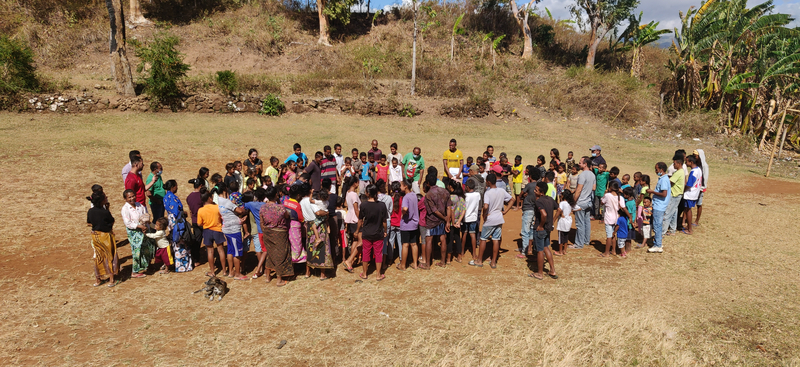
Community Wairoke watching Kalik game
- Importance (for practitioners, communities etc.):
While History is the story of integration and disintegration of human aggregates, Culture has been the greatest integrating force in men (Munshi 1965). The first characteristic of the culture is continuity. It comes from the past, adjusts itself to the present and moves forward to shape the future.
In a primitive society like Timor-Leste (pre-colonial context) the use of the written form as means of communication is unlikely considered. Oral language/expression has been used as the instrument of communication process; words are directly linked to events, meeting and things that take place. Furthermore, the community that rich in oral tradition (legends, myths and stories) such as in Timor-Leste, there is an indication of the consciousness of an ancient community (Vincent, 2016). Through the interview and FGDs with respondents it revealed that in some areas (e.g., Sanirin, Ponilala, and Venilale) talking about Kalik always link to culture (Uma Lulik) and therefore Kalik become a kind of product that anyone who come from Uma Lulic link to Kalik cannot discuss or talking about Kalik without permission from the elders or representative of that Uma Lulik. The reason is that it believes there will a consequence in terms of sickness or death for someone who discuss about Kalik without noticed to the elderly. However, this kind of permission do not have a relation with playing Kalik game; means anyone else can play Kalik at any time anywhere as they agreed to play. In addition, for those who not belong to that Uma Lulik they can discuss or talking about Kalik freely.
One of the very popular stories on Kalik told in this study, particularly in the municipality of Bobonaro, Ermera, and Baucau is the story of interpretation on the creation where heaven and earth are bound together by Kalik. According to tradition, people who were interviewed told that in long-gone days, earth and heaven are closed and connected by Kalik. One day an old woman went up to heaven to fetch fire; while in heaven she saw children playing ‘hana osan mutin’ (osan mutin is a kind of coin), and one of the osan mutins that was shot fell right near her feet. The old woman stepped on the osan mutin with her feet, so that the osan mutin would not be seen by the children (she plans to take that coin) because she took too long to get back to earth. This makes her husband angry, so he used a sword to cut the Kalik. Since that incident, heaven and earth separated and drifted away forever. According to oral tradition told by those interviewed in Atabae that Kalik to have risen in Gagaplau mountain of Atabae; while people in Sanirin and Ermera say that Kalik is raised in the village of Leimea leten, Atsabe from where the old women claimed from earth to heaven. This specific results on the story about Kalik obtained in this research, is not much different compared to the study on oral tradition stories in Timor-Leste reported by Vincent (2016).
Additionally, there are uma lisan (Clan) in Venilale and Bucoli, in the district of Baucau named: Luli Heni, if it is translated laterally means sacred or taboo kalik (luli means: sacred and Heni means Kalik in local dialogue) Furthermore, Kalik game in Timor-Leste is a kind of game that shows the representations, expressions, knowledge, skills and the object (Kalik) and cultural that associated with Timorese community or groups in the past - and in some cases individual and groups recognize as part of their cultural heritage. - Sources of information :
Books:
Luta Hamutuk, 2015, Promove jogu tradisional hodi defende Timor-Leste iha Futuru, Secretariadu Estadu Juventude no Disportu, DiliArticles:
Erskine, W., Xoimenes, A., Glazebrook, D., Da Costa, M., Lopes, M., Spyckerelle, L. and Williams, R. 2015, The role of wild foods in food security: the example of Timor-Leste, The Science, Sociology and Economics of Food Production and Access to Food, Springer, ISSN 1876-4517 Volume 7 Number 1Paulino, V. 2016, Writing and translating Timorese oral tradition, Configuracoes (online), http//journals.openedition.org/10.4000/configuracoes.3284
The information contained in the article comes from the following sources:
Estudu konaba identifikasaun Jogu Tradisional ‘KALIK’ iha Timor-Leste Husi Vicente de Paulo Correia, PhD; Matias Tavares, PhD; Oscar da Silva, MSc Faculdade Agricultura Universidade Nacional Timor Lorosa’e (UNTL) no GIZ Timor-Leste (Juventude ba Mudansa), 2021Source of photos used in this article and gallery:
All photos were provided by Malte Maschitzki, Development Advisor, State Secretary for Youth and Sport Timor-Leste - Gallery:
- Documents:
 Executive_summary_EN_-_Traditional_game_Kalik_in_Timor-Leste.pdf
Executive_summary_EN_-_Traditional_game_Kalik_in_Timor-Leste.pdf Relatorio_Peskiza_TET-_Jogu_Tradisional_KALIK_iha_Timor-Leste.pdf
Relatorio_Peskiza_TET-_Jogu_Tradisional_KALIK_iha_Timor-Leste.pdf Research_Report_EN_-_Traditional_Game_KALIK_in_Timor-Leste.pdf
Research_Report_EN_-_Traditional_Game_KALIK_in_Timor-Leste.pdf Sumario_executivo_PT_-_Jogo_Tradicional_KALIK_Timor-Leste.pdf
Sumario_executivo_PT_-_Jogo_Tradicional_KALIK_Timor-Leste.pdf Sumariu_ezekutivu_TET_-_Jogu_Tradisional_KALIK_Timor-Leste.pdf
Sumariu_ezekutivu_TET_-_Jogu_Tradisional_KALIK_Timor-Leste.pdf

